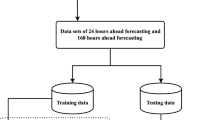Abstract
The forecasting methods of water bloom in existence are hard to reflect nonlinear dynamic change in algal bloom formation mechanism, leading to poor forecasting accuracy of bloom. To solve this problem, this paper deeply analyzes the generation process of algal bloom, introduces the recursive time series algorithm into the deep belief network model and improves the model structure and training algorithm, and proposes a forecasting method based on the recursive timed deep belief network model. The model introduces the current moments and historical time values of the characterization factors and influencing factors at the input layer, and increases the connection between the input layer and the hidden layer of the deep belief network. A recursive algorithm is used to establish the relationship between the current time value of the characterization factor and the historical time value of the characterization factor, and the connection between the current time value of the hidden layer and the influencing factor is increased. By re-extracting the characteristics of the hidden layer at each moment, and then fine tuning the network parameters by the BP neural network, a recursive timing deep belief network model is finally constructed. The results show that compared with the existing forecasting methods, this method can extract the characteristics of time series data more accurately and completely to deal with the dynamic nonlinear process and can further improve the forecast accuracy of algal blooms.





Similar content being viewed by others
References
Jin M, Ren Z, Shi JP et al (2010) Impact of agricultural non-point source pollution in eutrophic: water body of Taihu Lake. Environ Sci Technol 33(10):106–111
Li Y, Cao W, Su C et al (2011) Nutrient sources and composition of recent algal blooms and eutrophication in the northern Jiulong River, Southeast China. Mar Pollut Bull 63(5–12):249
Liu Z, Wu Q, Wang X et al (2008) Algae growth modeling based on optimization theory and application to water-bloom prediction. CIESC J 59(7):1869–1873
Wang L, Gao C, Wang X et al (2017) Nonlinear dynamics analysis and water bloom prediction of cyanobacteria growth time variation system. CIESC J 68(3):1065–1072
Klaychang W, Pochai N (2015) A numerical treatment of a non-dimensional form of a water quality model in the Rama-nine reservoir. J Interdiscip Math 18(4):375–394
Orouji H, Haddad OB, Fallah-Mehdipour E et al (2013) Modeling of water quality parameters using data-driven models. J Environ Eng 139(7):947–957
Wang X, Tang L, Liu Z et al (2012) Formation mechanism of cyanobacteria bloom in urban lake reservoir. CIESC J 63(5):1492–1497
Chen L, Shen Z, Yang X et al (2014) An interval-deviation approach for hydrology and water quality model evaluation within an uncertainty framework. J Hydrol 509(4):207–214
Wei J, Liu GB (2008) Overview of intelligent algorithms in nonlinear model predictive control. J Syst Simul 20(24):6581–6586
Wang L, Liu Z, Wu C et al (2013) Water bloom prediction and factor analysis based on multidimensional time series analysis. CIESC J 64(12):4649–4655
Gebler D, Kayzer D, Szoszkiewicz K et al (2014) Artificial neural network modelling of macrophyte indices based on physico-chemical characteristics of water. Hydrobiologia 737(1):215–224
Noori R, Yeh HD, Abbasi M et al (2015) Uncertainty analysis of support vector machine for online prediction of five-day biochemical oxygen demand. J Hydrol 527(6):833–843
Polania L, Barner K (2017) Exploiting restricted Boltzmann machines and deep belief networks in compressed sensing. IEEE Trans Signal Process 65(99):1–14
Qin F, Guo J, Sun W (2017) Object-oriented ensemble classification for polarimetric SAR Imagery using restricted Boltzmann machines. Remote Sens Lett 8(3):204–213
Yao M (2013) Application of improved genetic algorithm in optimizing BP neural networks weights. Comput Eng Appl 49(24):49–54
Kuremoto T, Kimura S, Kobayashi K et al (2014) ) Time series forecasting using a deep belief network with restricted Boltzmann machines. Neurocomputing 137(15):47–56
Li L, Cheng P, Lin H et al (2017) Short-term output power forecasting of photovoltaic systems based on the deep belief net. Adv Mech Eng 9(9):1–13
Jia Y, Wu J, Ben-Akiva M et al (2017) Rainfall-integrated traffic speed prediction using deep learning method. IET Intel Transp Syst 11(9):531–536
Kim J, Kang U, Lee Y (2017) Statistics and deep belief network-based cardiovascular risk prediction. Healthc Inform Res 23(3):169–175
Koesdwiady A, Soua R, Karray F (2016) Improving traffic flow prediction with weather information in connected cars: a deep learning approach. IEEE Trans Veh Technol 65(12):9508–9517
Gao Y, Su C, Li H (2018) A kind of deep belief networks based on nonlinear features extraction with application to PM2.5 concentration prediction and diagnosis. Acta Autom Sin 44(02):318–329
Wang G, Li W, Qiao J (2017) Prediction of effluent total phosphorus using PLSR-based adaptive deep belief network. CIESC J 68(5):1987–1997
Zhou F, Yin J, Yang Y et al (2016) Online recognition of human actions based on temporal deep belief neural network. Acta Autom Sin 42(7):1030–1039
Acknowledgements
This work was financially supported by National Natural Science Foundation of China (61703008), Support Project of High-level Teachers in Beijing Municipal Universities in the Period of 13th Five-year Plan (CIT&TCD201804014), and Major Project of Beijing Municipal Education Commission science and technology development plans (KZ201510011011). Those supports are gratefully acknowledged.
Author information
Authors and Affiliations
Corresponding author
Rights and permissions
About this article
Cite this article
Wang, L., Zhang, T., Jin, X. et al. An approach of recursive timing deep belief network for algal bloom forecasting. Neural Comput & Applic 32, 163–171 (2020). https://doi.org/10.1007/s00521-018-3790-9
Received:
Accepted:
Published:
Issue Date:
DOI: https://doi.org/10.1007/s00521-018-3790-9




